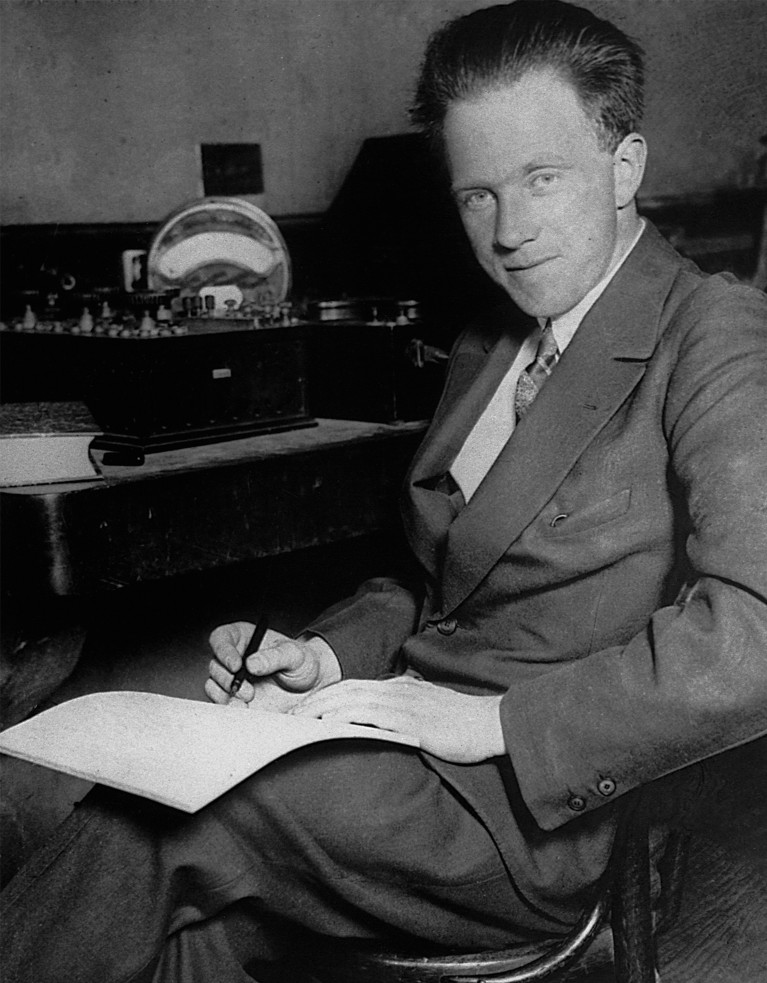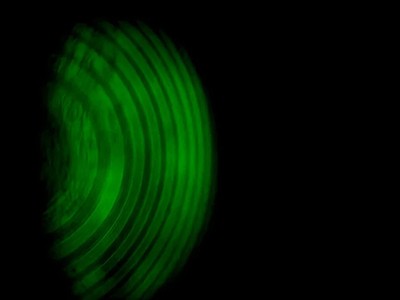In July 1925, a 23-year-old German physicist submitted a paper1 to the journal Zeitschrift für Physik entitled ‘On quantum-theoretical reinterpretation of kinematic and mechanical relationships’. The publication of Werner Heisenberg’s article was arguably the moment that ushered in the modern age of quantum mechanics, thus setting in train an astonishing revolution in our basic understanding of physics that has repercussions to this day. The United Nations has proclaimed 2025 to be the International Year of Quantum Science and Technology, in no small measure because of the events that began to unfold at breathtaking speed 100 years ago.
Heisenberg’s paper was a bold attempt to find a way out of difficulties that had plagued endeavours to explain atomic spectra — the frequencies and amplitudes of the light emitted and absorbed by atoms. His particular bone of contention was the Bohr–Sommerfeld model of the atom, named after the two physicists, Niels Bohr and Arnold Sommerfeld, who developed it in the 1910s. This model was a centrepiece of what has become known as the old quantum theory, which itself was the product of a realization at the turn of the twentieth century that the precepts of classical physics were not sufficient to explain observations of subatomic phenomena. This gap could, however, be closed by assuming, in an ad hoc way, that energy came in discrete packets: quanta.
Quantum mechanics 100 years on: an unfinished revolution
By supposing that electrons move in elliptical orbits around an atomic nucleus, subject to certain quantization conditions, the Bohr–Sommerfeld model provided a set of rules for selecting certain ‘allowable’ orbits of a classical system (in the case of the hydrogen atom, an electron orbiting a proton), delivering calculated values in agreement with the observed energy spectrum. The model had successfully explained the spectrum of the hydrogen atom — consisting of just one proton and one electron — and the splitting of spectral lines in the presence of an applied electric field (the Stark effect) or magnetic field (the ordinary Zeeman effect). But it had run into a host of problems in dealing with hydrogen molecules, and with atoms with more than one electron.
This was a problem that Heisenberg had uncovered when he joined the Institute for Theoretical Physics at the University of Göttingen, Germany, in 1923, as theorist Max Born’s assistant. He and Born had made a series of detailed calculations of the helium atom’s spectrum, using all of the orbits allowed by the Bohr–Sommerfeld model, but their results did not agree with experimental observations. Their early suspicions that the problem lay with the calculation methods soon gave way to a more fundamental misgiving. “It becomes increasingly probable,” Born wrote2, “that not only new assumptions will be needed in the sense of physical hypotheses, but that the entire system of concepts in physics will have to be rebuilt from the ground up.” Writing to Sommerfeld, his old teacher, in December 1923, Heisenberg noted that “none of the model representations really make sense. The orbits are real with respect to neither the frequency nor the energy.”
Heisenberg was not alone in expressing this doubt. His friend and frequent correspondent Wolfgang Pauli also became increasingly convinced that the idea of electrons moving in orbits was untenable, telling Sommerfeld in December 1924, “we are speaking a language inadequate to describe the simplicity and beauty of the quantum world.” Yet it was not clear how to proceed without the orbital models. As late as April 1925, Heisenberg wrote that in “the present state of quantum theory, one must rely on symbolic, model-like pictures that are more or less built on the mechanical behaviour of electrons in classical theory”3.
It was a couple of months later, when seeking respite from a bout of hay fever on the German island of Heligoland in the North Sea, that Heisenberg set out the kernel of a more drastic approach. Rather than constructing an atomic model based on the idea that electrons move along well-defined orbits in a roughly classical fashion, Heisenberg decided to develop an innovative theory of motion, a ‘quantum mechanics’ in which electrons could no longer be thought of as particles that move along continuous trajectories. On 9 July, he wrote to Pauli that “all my wretched efforts are devoted to killing the concept of orbits completely — which cannot be observed anyway”. This was the decisive break with classical mechanics.

Werner Heisenberg, pictured in 1925.Credit: Corbis via Getty
In his paper1, which was submitted a few weeks later, he set out “to establish a basis of theoretical quantum mechanics founded exclusively on relationships between quantities that in principle are observable”. Heisenberg formulated an equation of electron motion based on the classical equation of motion for a periodic system. In place of quantities such as position and momentum, it included complex arrays of observable energies and transition amplitudes (the probabilities of atoms undergoing a transition from one quantum state to another).
This was a strategy born more out of desperation than from any philosophical conviction. As Heisenberg explained in the paper’s introduction, in light of the complexities involved in dealing with atoms with several electrons, “it seems sensible to discard all hope of observing hitherto unobservable quantities such as the position and period of the electron”.
Does quantum theory imply the entire Universe is preordained?
However, it was difficult to see how the elimination of unobservable quantities would guide the further development of the theory. Before the theory could describe phenomena such as collisions and the motion of free particles, it would have to include other quantities in addition to energies and transition amplitudes. Beyond that, it was not even clear which quantities should be regarded as unobservable. The electron position, for example, was re-admitted as being observable in 1927. As Born reflected decades later, the idea of eliminating unobservable quantities had sounded reasonable enough in 1925, but in practice such a “general and vague formulation is quite useless, even misleading”.
Pragmatic considerations lay at the heart of Heisenberg’s physics. He often played with all sorts of ideas until he found one that worked — an approach well suited to a period of such conceptual turmoil. Philosophical principles were typically used as a means of overcoming an impasse, or as a last resort, and could be discarded when they were no longer useful. As Born would later note, the real value of philosophical principles for the working physicist can be judged “only according to their relative usefulness in producing results”.
Matrices or waves?
Heisenberg was adamant that only a “more intensive mathematical investigation” would reveal whether the method he had used in his July paper could “be regarded as satisfactory”. This was done by Born and Pascual Jordan in Göttingen in the months that followed. Realizing that the quantities that appeared in Heisenberg’s equations could be represented as matrices (a form of mathematics unfamiliar to most physicists at the time), they recast the theory in these terms. Their innovative ‘matrix mechanics’ was set out in a long paper4, commonly known as the Dreimännerarbeit (the three-man paper) submitted by Born, Heisenberg and Jordan in November 1925.
But this model came at a price. As the authors explained, the new theory had “the disadvantage of not being directly amenable to a geometrically visualizable interpretation, since the motion of electrons cannot be described in terms of the familiar concepts of space and time”. Whereas Born and Jordan revelled in the abstraction, Heisenberg could not help but wonder in a letter to Pauli in June 1925 “what the equations of motion really mean”. Pauli’s successful calculation5 of the hydrogen atom spectrum using the scheme in December that year was widely regarded as a vindication of the effort. But most physicists found it difficult to come to terms with the abstruse mathematics. It was a welcome relief when an altogether different approach appeared just a few months later, in the first half of 1926.
This came in the form of a series of groundbreaking papers in the Annalen der Physik published by Erwin Schrödinger6, working at the University of Zurich, Switzerland. The idea that the motions of electrons could not be described in space and time was, as far as Schrödinger was concerned, an abdication of the physicist’s responsibility, and amounted to abandoning all hope of ever understanding the atom’s inner workings. Such an understanding, Schrödinger maintained, was possible. Admitting in a footnote to one of the papers that he was “repelled by” the Göttingen approach to quantum mechanics, he instead formulated a wave equation that enabled him to calculate the energy states of the hydrogen atom. For Schrödinger, this promised a more intuitive understanding of quantum states as a “vibration process in the atom”. Rather than thinking of electrons as particles moving in orbits, he proposed that they could be thought of as waves, with a continuous distribution of electric charge in 3D space.
‘Shut up and calculate’: how Einstein lost the battle to explain quantum reality
Heisenberg was having none of it. After attending a colloquium in Munich, Germany, at which Schrödinger presented his theory, Heisenberg complained to Pauli that the wave theory could not account for a host of quantum phenomena, including the photoelectric effect — the emission of electrons from a metallic surface when it is illuminated — and the Stern–Gerlach effect, in which a beam of atoms was found to deflect in one of two ways when passing through a spatially varying magnetic field. Moreover, describing a many-particle system required a wavefunction in an abstract multidimensional space. The wavefunction was undoubtedly a useful calculational tool, but it didn’t seem to describe anything like a real wave. “Even if a consistent wave theory of matter in the usual three-dimensional space could be developed,” Heisenberg wrote in June 1926, “it would hardly yield an exhaustive description of atomic processes in terms of our familiar space-time concepts”7.





